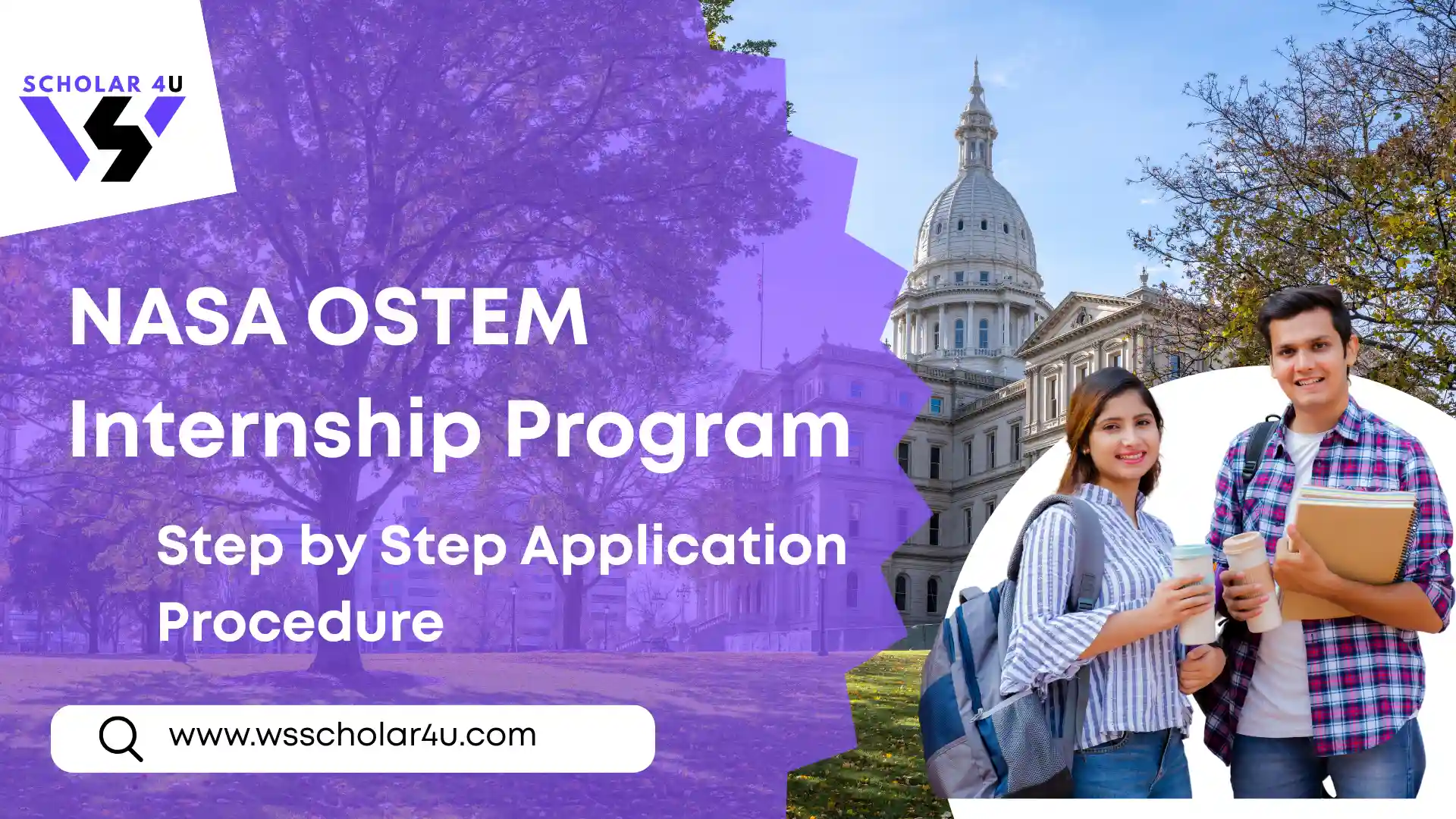Table of Contents
ToggleHave you ever dreamed of contributing to groundbreaking missions, exploring the cosmos, or developing the technology that shapes the future? The NASA OSTEM Internship Program is more than just a summer job; it’s a launchpad for your career. This program offers a unique opportunity for students to work alongside some of the world’s leading scientists, engineers, and researchers. By providing hands-on experience and mentorship, OSTEM internships help turn academic knowledge into practical skills, creating a direct pathway to a rewarding career in science, technology, engineering, and mathematics (STEM).
The article at WsScholar4u will guide you through what the program is, who can apply, the application process, what to expect, and the long-term career benefits. We will provide specific, actionable advice to help you craft a strong application and secure a position. This guide is your definitive resource for navigating the NASA OSTEM internship journey and launching your professional future.
What Is the NASA OSTEM Internship Program?
The NASA Office of STEM Engagement (OSTEM) is dedicated to inspiring the next generation of explorers. The internship program is one of its primary initiatives, designed to immerse students in the real-world work of NASA. These internships are available at various NASA centers across the United States, including the Johnson Space Center in Houston, Texas; the Kennedy Space Center in Cape Canaveral, Florida; and the Jet Propulsion Laboratory in Pasadena, California. Interns work on diverse projects, from developing software for Mars rovers to testing new propulsion systems for spacecraft. The program is offered during three sessions: a 10-week summer session, a 16-week fall session, and a 16-week spring session.
The Mission and Goals of the Program
The core mission of the OSTEM internship program is to provide students with authentic NASA experiences. The program’s goals are to strengthen the STEM workforce pipeline, provide high-quality educational experiences, and inspire a diverse talent pool. NASA achieves these goals by pairing interns with a mentor who guides them through a specific project. This mentorship model ensures that students not only gain technical skills but also develop professional communication, teamwork, and problem-solving abilities. The program aims to give students a clear understanding of what a career at NASA entails and how they can contribute to the agency’s mission.
NASA’s OSTEM vs. Other Internship Programs
While many organizations offer internships, the NASA OSTEM program stands out due to its specific focus and mission. Unlike a typical corporate internship that might involve marketing or business development, NASA’s program is deeply rooted in scientific research, engineering challenges, and technological innovation. Interns at NASA are not simply fetching coffee; they are actively contributing to missions with real-world impact. Projects might include designing components for the Artemis program, analyzing data from the James Webb Space Telescope, or participating in the development of new aeronautics technologies. The program offers an unparalleled opportunity to work on projects that are literally out of this world.
Eligibility and Requirements for Applicants
Securing a coveted spot in the NASA OSTEM internship program requires meeting a strict set of criteria. Knowing these requirements is the first step toward crafting a strong application.
Academic Standing and GPA
To be eligible, you must maintain a strong academic record. NASA requires a minimum cumulative GPA of 3.0 on a 4.0 scale. While this is the minimum, successful applicants often have GPAs well above this threshold. Strong grades in science and math courses are particularly important, as they demonstrate your foundational knowledge and commitment to your studies. Academic transcripts from your university or college will be required to verify this information during the application process.
Citizenship and Age Requirements
The OSTEM program has specific citizenship and age requirements. Applicants must be U.S. citizens. This is a non-negotiable requirement for all OSTEM internships. Additionally, you must be at least 16 years old at the time the internship begins. There is no upper age limit for the program, making it accessible to a wide range of students, from high schoolers to graduate students.
Enrollment Status and Major
The program is designed for currently enrolled students. You must be enrolled full-time or part-time in a degree-seeking program at an accredited college, university, or high school. This includes undergraduate, graduate, and even high school students who are at least 16 years old. While STEM majors are most common, NASA considers applicants from a variety of fields. Successful candidates often major in subjects like aerospace engineering, computer science, physics, and planetary science. However, NASA also needs students with skills in fields such as communications, business administration, and public policy to support its diverse operations.
Skills and Experiences Valued by NASA
NASA looks for more than just good grades; it seeks students with specific skills and experiences. They value candidates who can demonstrate leadership, teamwork, and problem-solving abilities. You should highlight your experience with projects, such as a senior design project, a robotics competition, or a research opportunity. NASA also looks for technical skills, including proficiency in programming languages like Python or C++, experience with CAD software like SolidWorks, or knowledge of laboratory techniques. These experiences show that you have the practical skills needed to contribute to a team.
The Application Process Step-by-Step
Navigating the application process can be complex, but following these steps will make it much more manageable.
Finding the Right Internship Opportunity
The first step is to explore the available opportunities. NASA uses the NASA STEM Gateway portal to list all available internships. You should use the portal’s search filters to find positions that align with your major, skills, and career interests. Read the descriptions carefully to understand the specific project, required skills, and location. It is helpful to identify several positions you are qualified for and interested in, as this increases your chances of being selected.
Creating an Account on the NASA STEM Gateway
Once you have identified potential internships, you must create a profile on the NASA STEM Gateway. The application portal allows you to build a comprehensive profile that serves as your primary application. You will need to provide personal details, educational history, academic transcripts, and a detailed resume. This portal is also where you will upload your resume and any other required documents.
Preparing Your Application Materials
A strong application requires meticulous preparation. Your resume should be tailored to highlight skills and experiences relevant to the specific internship you are applying for. When describing your experiences, use specific examples and quantifiable achievements. For instance, instead of saying, “worked on a project,” say, “developed a new algorithm that reduced data processing time by 15%.” Additionally, you will be asked to write a personal statement. The personal statement is your chance to tell your story and explain why you are passionate about NASA’s mission. Use this opportunity to connect your academic and personal experiences to the goals of the internship.
Navigating the Interview and Selection Phase
If your application is successful, you will likely be invited for an interview. Interviews are typically conducted via video conference or phone. Be prepared to discuss your resume, academic background, and specific projects you have worked on. Interviewers may ask behavioral questions, such as “Tell me about a time you faced a difficult technical challenge and how you overcame it.” Practice your answers and be ready to articulate your skills and enthusiasm. The selection process is competitive, but a well-prepared candidate can stand out.
What to Expect as an OSTEM Intern
A NASA OSTEM internship is a transformative experience. Knowing what to expect will help you make the most of it.
Project Work and Mentorship
As an intern, you will be assigned to a specific project and paired with a NASA mentor. Your mentor, who is a NASA scientist or engineer, will provide guidance and support throughout your internship. You will be expected to contribute to your project, which could involve tasks like conducting laboratory experiments, writing code for a simulation, or analyzing scientific data. This hands-on work is the cornerstone of the experience.
Internship Sessions and Locations
NASA offers three internship sessions: summer (June to August), fall (August to December), and spring (January to May). The summer session is the most popular and competitive. Internships are available at over a dozen NASA centers and facilities, including Ames Research Center in California, Goddard Space Flight Center in Maryland, and Langley Research Center in Virginia. Each location has a unique focus, such as aeronautics, planetary science, or space exploration.
Benefits and Stipend Information
All NASA OSTEM internships are paid. The amount of the stipend varies based on your academic level and the number of hours you work. Undergraduate interns can expect to receive a stipend of around $7,200 for a 10-week summer session. Graduate students and students with more experience may receive a higher stipend. The stipend is intended to cover living expenses, such as housing and food.
Professional Development and Networking
Beyond the project work, the OSTEM program provides invaluable opportunities for professional development and networking. You will have access to workshops, seminars, and lectures from NASA experts. You will also have the chance to connect with fellow interns, forming a network of future scientists and engineers. Many NASA centers host special events, tours, and presentations, all designed to enhance your learning and professional growth.
Launching Your Career with NASA
A NASA OSTEM internship is more than a temporary position; it is often the first step toward a long and successful career in a STEM field.
The Long-Term Impact of a NASA Internship
An internship at NASA significantly boosts your resume. It demonstrates to future employers that you have the skills, dedication, and experience to contribute to a high-stakes, technically demanding environment. Many OSTEM alumni credit their internships with helping them secure funding for graduate school, land their first full-time job, or secure a position at a prestigious research institution.
Future Opportunities at NASA
For many, the ultimate goal is to work for NASA full-time. A successful internship can lead to a direct pipeline for future employment. NASA often hires former interns into full-time positions through programs like Pathways, which are designed to transition students into permanent roles. An internship is the best way to get your foot in the door and make a lasting impression on hiring managers.
Testimonials and Success Stories
Thousands of students have launched their careers through the OSTEM program. Consider the success stories of former interns who now work as project managers for the Artemis mission, scientists analyzing data from the Hubble Space Telescope, or engineers designing the next generation of spaceflight hardware. These individuals demonstrate that the experience gained during an internship is directly applicable to a long-term career at NASA. Their journeys are a testament to the program’s effectiveness in developing talent.
Official Website
For more information and to begin your application, please visit the NASA STEM Gateway.
FAQs
Can high school students apply for a NASA internship?
Yes, high school students can apply for NASA’s OSTEM (Office of STEM Engagement) internship program. To be eligible, you must be at least 16 years old at the time you apply and be a U.S. citizen. You also need to meet the program’s GPA requirements.
What is the GPA requirement for a NASA OSTEM internship?
The minimum GPA (Grade Point Average) you need for a NASA OSTEM internship is a 3.0 on a 4.0 scale. If your school uses a different grading scale, make sure to see how it compares to a 4.0 scale.
How hard is it to get a NASA OSTEM internship?
It’s very competitive to get a NASA internship. Thousands of students apply for a limited number of spots. However, NASA looks for more than just good grades. They also want to see that you are passionate about space, curious, a good team player, and able to solve problems. Having a strong resume with relevant projects and skills can help you stand out.
What kind of work do NASA OSTEM interns do?
NASA interns work on real projects that help with NASA’s missions. You could be helping with rocket design, writing code for robots, doing research on planets, or working on communications and business projects. The projects vary widely and are based on the needs of each NASA center.
Are NASA OSTEM internships paid?
Yes, NASA OSTEM internships are paid. Interns receive a stipend, which is a set amount of money for the time they work. The amount you get depends on your education level (high school, undergraduate, or graduate student) and how long your internship lasts.
Do you have to be a STEM major to get a NASA internship?
No, you do not have to be a STEM major to get an internship at NASA. While many opportunities are for science, technology, engineering, and math students, NASA also has internships for students in other fields. These can include communications, business, law, and liberal arts.
How do I apply for a NASA OSTEM internship?
You apply for a NASA OSTEM internship through the NASA STEM Gateway portal. You’ll need to create an account, fill out an application, and upload documents like your resume and school transcripts. One application lets you be considered for many different projects across all NASA centers.
When are the application deadlines for the NASA internship program?
NASA offers three internship sessions a year: spring, summer, and fall. The application deadlines are different for each session. You should check the official NASA internship website for the most up-to-date dates, but generally, applications close several months before the session begins.
What is the difference between a NASA OSTEM internship and a Pathways internship?
OSTEM internships are short-term, temporary positions, usually lasting one session (like a summer). The Pathways program is different because it is a paid, long-term internship that can lead to a full-time job at NASA after you graduate.
Are interviews required for a NASA OSTEM internship?
Some NASA mentors may want to interview you for a project. However, an interview is not always required. Be prepared for a possible phone or video interview, and be sure to check your email and phone regularly after you apply so you don’t miss any messages.





